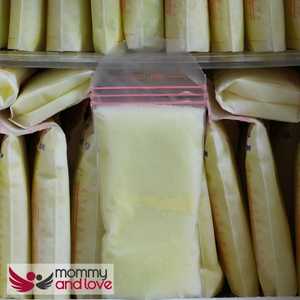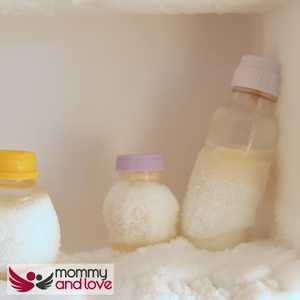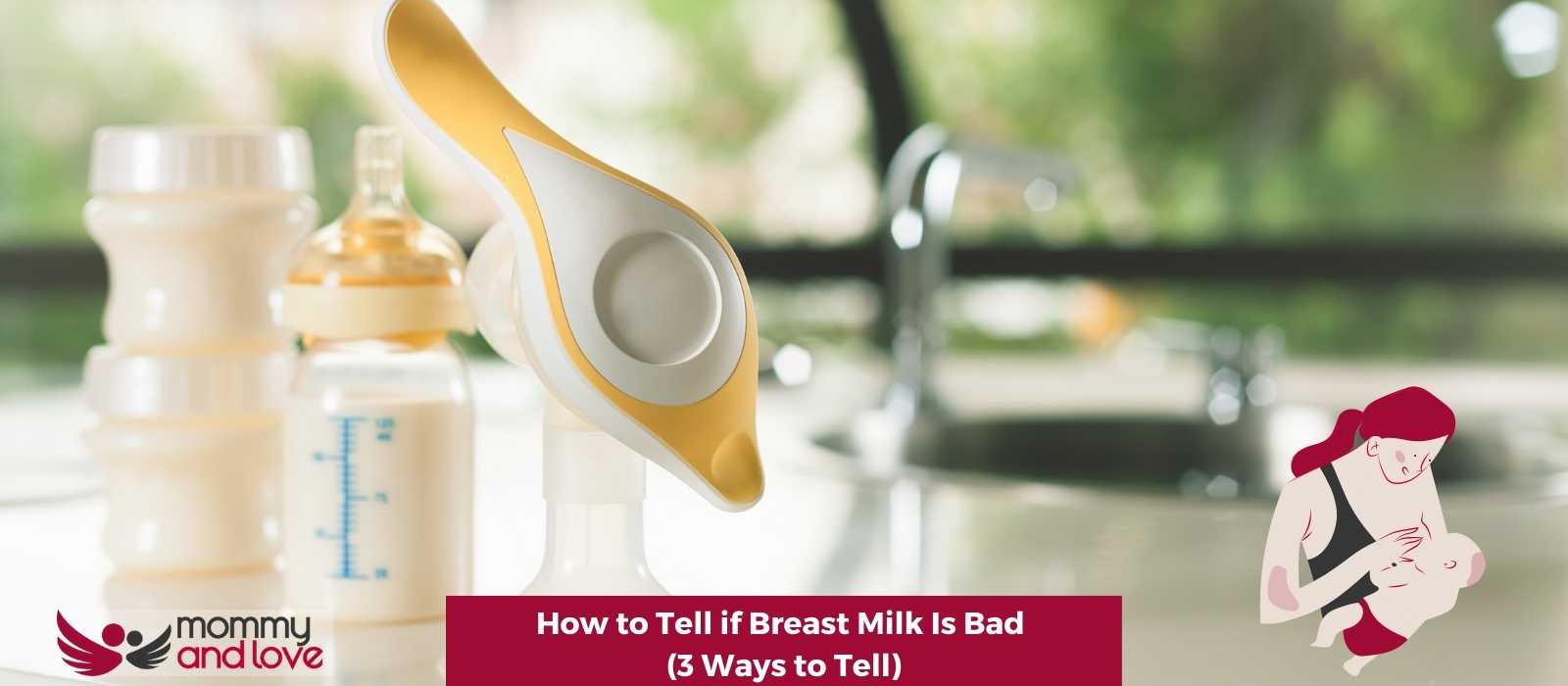No matter how much you love your little one, there may come a time when you have to throw out their breast milk. Maybe it’s been in the fridge for too long, maybe it doesn’t smell right – whatever the reason, knowing how to tell if breast milk is bad is crucial. Here are three ways to do just that.
Your gut instinct is probably the best way here. If something smells off or just doesn’t seem right, it’s probably time to toss the milk. The texture is another clue that your milk has gone bad. If it’s lumpy, grainy, or clumpy, it’s time to say goodbye. If the milk has turned a different color than usual, that’s a sign. However, we go through each of these in-depth, just in case your ‘spoiled’ breast milk isn’t spoiled!
It’s important to keep in mind that breast milk is perishable, so you should always aim to use it within a few hours of expressing it. If you can’t use all of your milk right away, you can freeze it for later use. Just be sure to label it with the date, and thaw it in the refrigerator before using.
Does Breast Milk Go Bad?
Yes, breast milk can spoil. Just like cow’s milk or any other type of milk, breast milk contains proteins, lactose, and fat. These components will start to break down and spoil when the milk is stored at a temperature that is too high or too low. In general, it’s best to store breast milk in the refrigerator or freezer.
If you’re using frozen breast milk, it’s best to thaw it slowly in the refrigerator. You can also use a microwave, but be sure to heat it evenly and avoid hotspots. Heating breast milk too quickly can destroy some of its beneficial nutrients. Once the milk is thawed, it should be used within 24 hours.
If you’re using refrigerated breast milk, it’s best to use it within four days. However, breast milk can be stored in the fridge for up to two weeks. If you need to store breast milk for longer than two weeks, you can freeze it. Breast milk that has been frozen should be thawed slowly in the refrigerator and used within 24 hours.
While breast milk is safe to drink after it has been stored, its quality will start to decline over time. So it’s best to use fresh breast milk whenever possible. If you have any leftover breast milk, you can store it in the fridge or freezer for later use.
How long does breast milk last?
The shelf life of breast milk depends on a number of factors, including how it is stored and the type of container used. In general, breast milk can last for up to six hours when refrigerated and for up to one day when frozen.
On the Counter
Breast milk will last for up to four hours on the counter. However, this depends on the temperature of the room it is in. If excessively hot, it may not last that long.
In the Refrigerator
Breast milk will last for up to six days in the refrigerator if it is stored in a clean container. Remember to put it at the back of the refrigerator and not to leave it in the fridge door.
In the Freezer

If breast milk is frozen, it will last for up to two months. In a deep freezer, it will last for up to six months.
If you’re pumping breast milk and storing it in the fridge or freezer, it’s important to label each container with the date so that you know when it’s been sitting around for too long.
In an Insulated Cooler
If breast milk is stored in an insulated cooler with ice packs, it will last for up to 24 hours. Again, it’s worth time-stamping each bottle so you know when you pumped the expressed breast milk and how long it has been stored.
It is important to remember that the quality of breast milk diminishes over time. The older the milk is, the less nutritious it becomes. It is best to discard any milk that has been frozen for more than six months or use it for alternative uses like making soap or having a breast milk bath. We’ve done a guide to the best uses for excess or spoiled breast milk.
How do I know if my breast milk went bad?

The signs that breast milk has gone bad are usually pretty obvious. If it smells rank, off, or sour, it’s likely past its prime.
Also, if the milk has started to form clumps, curdle, or change color, it’s a sign that it’s gone bad. If you’re ever in doubt about whether or not your milk has spoiled, it’s best to discard it and start fresh.
Taste Your breast milk
Taste is also a good indicator of spoilage. If the milk tastes sour, metallic, or otherwise unpleasant, it’s probably time to chuck it. However, this a sign of sour or soapy milk may just be a sign of too much lipase, so this is not always considered reliable.
Smell Your Breast Milk
The smell of milk is often a good indicator of spoilage. If it smells rank, sour, or off, it’s likely spoiled and unsafe to drink. However, a bad odor may also be caused by bacteria that are not harmful. If you’re ever in doubt, it’s always best to throw the milk out and start over.
Appearance of Your Breast Milk
The appearance of breast milk can also be a sign of spoilage. If it’s thick, lumpy, or has changed color, it may not be safe to drink. The breast milk color can vary wildly but if it looks lumpy then this is a sign the baby milk has gone bad.
Guidelines for Storing Breast Milk
If you are a breastfeeding mother, you may be wondering about breast milk storage to avoid breast milk spoilage. Here are some guidelines to follow to avoid spoiled milk:
1) Store your freshly expressed milk in clean, sanitized containers. You can use bottles, bags, disposable bottle liners, or even ice cube trays to freeze your freshly pumped milk.
2) Label each container with the date and time it was expressed. Remember to use your oldest breast milk first, as just like other milk human milk deteriorated over time.
3) Store your milk in the fridge or freezer, depending on how long you plan to store it. Fresh milk can be stored in the fridge for up to five days, while frozen milk can be stored for up to six months. If you are freezing breast milk remember to date stamp each batch. If there is a soapy smell then this might be due to excess lipase and is not an issue you can just scald breast milk
4) Thaw your milk before feeding it to your baby. Frozen milk can be thawed in the fridge overnight, or you can use the defrost setting on your microwave.
5) Discard any milk that has been stored past the expiration date.
Storing breast milk is an important part of breastfeeding. By following these guidelines, you can ensure that your milk is safe and fresh for your baby. Always ensure that your breast pump
and parts are thoroughly clean, dry and sterilized.
Factors affecting stored breast milk
The quality of stored breast milk can be affected by a number of factors, including:
1) Temperature – Milk stored at a higher temperature will spoil more quickly.
2) Duration – The longer milk is stored, the more likely it is to spoil.
3) Type of container – Plastic containers are more likely to spoil than glass containers.
4) Light – Exposed milk will spoil more quickly.
5) Age of the milk – Fresh milk is always best.
6) Presence of bacteria – Bacteria can cause milk to spoil. Ensure your equipment is thoroughly washed, dried and sterilized before using.
By keeping these factors in mind, you can help ensure that your stored breast milk is safe and fresh for your baby.
Tell me the best container for storing expressed milk?
There is no one definitive answer to this question as different mothers have different preferences and needs. Some mothers prefer to store their milk in bottles, while others prefer bags or even ice cube trays. It is important to choose a container that is clean, sanitized, and tightly sealed. Milk stored in a plastic container is more likely to spoil than milk stored in a glass container, and exposed milk is more likely to spoil than milk that is kept in the fridge or freezer. It is also important to label each container with the date and time it was expressed. This will help you keep track of how long each batch of milk has been stored.
Can I add freshly expressed breast milk to already stored milk?
Yes, you can add freshly expressed breast milk to breast milk stored. However, you should only do this if you are sure that the milk has been stored at the correct temperature and for the correct amount of time. You should also make sure that the container you are using for storage is clean and sterile. If you are adding fresh milk to frozen milk, you should thaw the frozen milk first and never add warm breast milk to frozen milk
Does Thawed Breast Milk Taste Different From Fresh Breast Milk?
Most batches of thawed milk will taste different to one another depending on the mother’s diet. If you have excess lipase this can also affect stored breast milk. However, thawed breast milk is perfectly safe and babies usually lap it up!
Take Away on How to Tell if Frozen Breast Milk Is Bad
Breast milk can spoil and it is vital to refrigerate or freeze pumped breast milk as soon as you can. If your milk smells sour or soapy this may not be down to the fact it has spoiled, it might just be a sign of excess lipase activity. Always ensure your storage containers that are handling breast milk are thoroughly cleaned, dried and sterilized. Remember, mother’s milk is liquid gold and you want to ensure it is not wasted!
If your baby refuses their milk or it smells off, has a sour taste or you suspect it’s gone off, use it for something else other than feeding your baby!

This article was written by Sandra Baker – full time writer and the mother of four amazing kids (including twins!)
She’s also a breastfeeding counselor and has spent years helping new parents learn how to care for their children. When she’s not writing or caring for her children, Sandra likes to spend time reading and taking walks with her husband.




